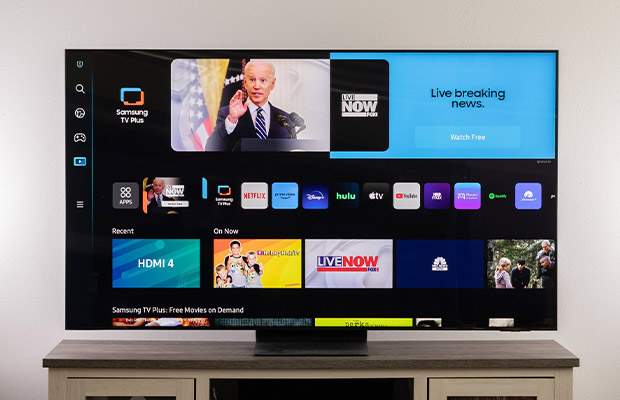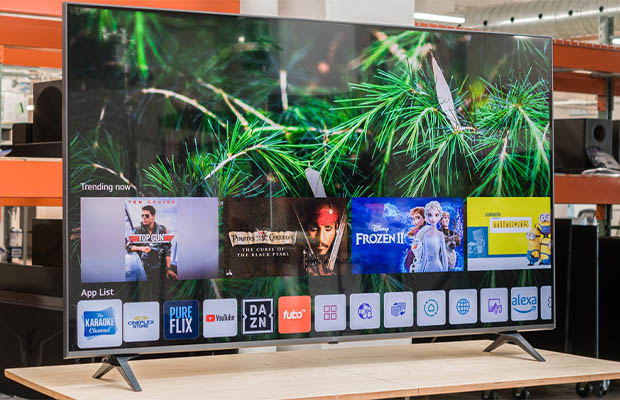We all desire to have a TV in our homes, so if you enjoy watching TV, you may be interested to learn how much that activity affects your energy costs.
So how many amps does a TV use? Model, screen size, screen type, and other features are all significant factors to consider when calculating the average TV amperage.
You can read more about how much energy your TV uses, and how to reduce energy usage below.
Table of Contents
How Many Amps Does a TV Pull?
The typical 113W, 120V TV will consume 0.95 amps. However, due to variations in features and screen size, wattage consumption of TV varies from model to model. Additionally, this explains why various TVs draw different amounts of amps.
For instance, you are interested in learning how many amps your 55-inch TV consumes. To find the total amps, all you have to do is multiply the wattage by the voltage.
Your 55-inch flat-screen TV uses only 1.25 amps when using 150 watts and 120 volts. If you want to run your TV in this scenario along with other lower-amp appliances on the same circuit, there won’t be any issues.
The terms amperage, wattage, and voltage are briefly defined below to help you understand these electrical ratings.
Amperage
The amperage, which can be expressed in amps or amperes, refers to the current that is flowing through the circuit.
Wattage
The energy consumption of a particular device is determined by its wattage. Typically, equipment with a higher wattage uses more energy than equipment with a lower wattage.
Voltage Supply
The primary source of energy for each household is referred to as the voltage supply. Since you’ve probably seen ratings of 110V, 120V, as well as 220V and 230V, you might be curious about how many volts we use in a typical household.
These ratings only apply to the 110V and 220V main supplies, which are US-standard voltages, so don’t be confused. Some nations, such as the UK, only use 220V as their standard outlet supply.
You can calculate TV amps using the terms and calculation above. On the other hand, determining the cost necessitates a different calculation.
Continue reading to learn how much your TV costs in energy annually.
KWh Per Year
You can calculate your annual energy usage in kWh. The amount of power (watts) or kW as well as the number of hours the device is used are included. How much electricity your TV uses each year is shown here.
You must first realize that 1 kW is equal to 1000 watts. Consequently, to calculate the kW consumption of a 65-inch TV, you must divide the 150 watts it uses by 1,000. This will give you 0.15 kW, which you must multiply by the quantity of hours used to get kilowatt hours (kWh).
Assuming you watch TV for five hours per day on average, 0.15 kW times five hours equals 0.75 kWh. By dividing this amount by the 365 days in a year, you can calculate the energy consumption of the TV annually.
Your 150-watt, 65″ TV uses 273.75 kWh of energy annually as a result.
Cost Per Year
The annual cost of energy that you pay is referred to as “cost per year” here. Energy costs, however, are not fixed because they depend on your local utility company. This means that it might be high or low.
You must multiply the total annual kWh consumption by the assumed energy rate in your location, which is 11 cents per kWh. In this instance, the annual electricity cost for a TV using 273.75 kWh is $30.
Factors That Affect TV Power Cost
Screen size, viewing hours, brightness level, and TV type are a few variables that have an impact on the cost of TV power. Although there are many other factors at play, these are some of the most significant ones.
Let’s look at each of these factors:
AD
1. The Screen Size
The part of your TV that consumes the most energy is the screen. No, it’s not just because it’s the biggest; it’s also because it’s the part that does the bulk of the work. As a result, the power consumption increases with screen size.
2. Watching Hours
It’s pretty obvious what this one is. The longer you watch TV, the more energy it uses. Therefore, watching TV for five hours per day will use more energy than watching it for two.
3. Brightness Level
Your TV’s brightness level has an impact on power usage as well. The brighter the screen, the more power it will use. So your TV will use more energy when operating at a high brightness setting than when it is set to a low brightness level.
4. The TV Type
3. Older TV types like CRT and Plasma are less efficient than newer types like LCD, LED, and OLED. Therefore, you should prepare to pay more for your energy bills if your TV is older. It is for this reason that I strongly advocate the latter technologies.
5. Internet Connectivity
You’ll see that when you’re connected to the internet, your phone uses more power than when you’re not. This is due to the fact that it must process and receive data from various servers. Your TV is the same way. A smart TV that is online will use more power than one that isn’t.
Types of TVs Determine the Amperage for Television Use
Below we list the most common types of TV.
Tube Television
With an average power consumption of 150 watts for a 32-inch screen and 80 watts for a 19-inch screen, tube TV, also known as CRT, uses the most energy.
Plasma TV
This TV creates images using plasma technology, as the name suggests. About 160 watts on average are used by a 32 inch screen.
LCD TV
A type of TV that uses liquid crystal is called an LCD (Liquid Crystal Display). Compared to the previous two types, it has a higher-quality picture. A 32-inch screen display uses 65 to 70 watts of energy on average.
LED TV
In order to process and produce an image, LED (Light Emitting Diodes) TVs use LED lamps. Additionally, this kind of TV is renowned for its energy efficiency, requiring only an average of 35 watts for a screen that is 24 inches in size and 41 watts for a screen that is 32 inches.

OLED TV
A better image quality than LED TVs is provided by OLED (Organic Light Emitting Diode) TVs. This kind of device has been upgraded to an AMOLED (Active Matrix Organic Emitting Diode) as technology advances.
OLEDs typically require 57 watts for screens under 32 inches and 75 watts for screens over 43 inches.
UHD TV
When it comes to resolution or picture quality, UHD TV is the best. It typically starts at 3840 pixels wide by 2160 pixels tall, also known as 2160p TV or 4K TV, and the most recent model is 8K UHD TV.
In comparison to LED and OLED TVs, a 4K UHD TV has an average TV wattage of 80.
Smart TV
A smart television can access the internet (via LAN cable or Wi-Fi) and let us watch videos online. Average power usage for this TV model is 157 watts.
Read More:
How to Calculate the Number of Amps TV Uses?
You need to know the wattage of your TV in order to determine how many amps it consumes. Once you have that information, just divide it by the voltage of your outlet.
For example, if you have a TV that uses 100 watts of power and you’re using it with a 120-volt outlet, the calculation would look like this:
Amps = Watts / Volts
Amps = 100W / 120V
Amps = 0.83
This indicates that your TV would draw 0.83 amps from a 120-volt outlet.
The wattage would need to be divided by 240 rather than 120 if you wanted to use a 240-volt outlet. So, in our example, the calculation would look like this:
Amps = Watts / Volts
Amps = 100W / 240V
Amps = 0.42
How to Reduce Your TV’s Energy Usage?
Hopefully, learning about your television’s amp usage and energy costs came as a welcome surprise. You’re in the right place, though, if you’re currently scrambling to figure out how to cut back on the energy you use to watch your favorite programs.
Thankfully, more recent televisions have a variety of settings that can lower their power requirements while in operation. We suggest:
- Reducing the brightness — Your TV needs to draw more power the brighter it is. Manually reduce the brightness using your remote.
- Turn it off when not in use — Don’t just leave it idly running all day! When not in use, unplug it completely or turn the outlet off.
- Use the built-in energy efficiency features — Energy efficiency settings are available on smart TVs. They permit you to activate power-saving mode on the gadget. However, the screen is frequently dimmed by the auto-brightness feature at random intervals, which could reduce your user experience.
- Alter the contrast — Your television will use significantly less energy if you also lower the contrast and brightness.
You May Also Like: How to Connect Apple TV to Wifi Without Remote?
FAQs
How Many Amps Does a 65-Inch TV Use?
A 65-inch TV typically uses 1.24 amps at 120 volts and 0.62 amps at 240 volts for its apps. Again, 1.24 is just an average, so your TV may use more or less. To get accurate amperage, check the wattage on your TV.
How Many Amps Does a 70-Inch TV Use?
When plugged into a 120-volt outlet, a 70-inch TV will typically draw 1.4 amps. The slight difference in amps between a 65-inch and 70-inch TV is due to the larger screen and other components’ greater electricity requirements compared to smaller models.
How Many Amps Does a 12V TV Use?
An average of 5 amps may be required to power a 12V, 60-watt, 19-inch television. Your battery’s capacity will determine how long it can be used.
How Many Amps Does a Fridge Use?
The average refrigerator uses 725 watts of power and 10 to 20 amps.
How Many Amps Does a Mini Fridge Use?
In general, mini-fridges use between 55 watts and 85 watts, but many can run up to 240 watts.
How Many Amps Does a Microwave Use?
A typical microwave oven uses on average 1000 watts of power, which is equal to about 8.3 amps.
How Many Amps Does a Dryer Use?
Residential Household dishwashers use 10 amps of power, mostly.electric dryers draw anywhere from 7.5 to 30 amps.
How Many Amps Does a Dishwasher Use?
Household dishwashers use 10 amps of power, mostly.
Conclusion
For the safety of the circuit, it is crucial to know how many amps a TV uses as well as its consumption rating. This information may also affect how you use your appliance.
There are a few variables that affect TV power costs, including how many hours you watch each day, your local power/utility rates, and the settings on your TV.
Our aforementioned advice will undoubtedly be useful to you if you want to conserve energy while watching television.
Read Next: How To Cast Oculus Quest 2 To Roku TV?



MOST COMMENTED
How to
How to Clean Homedics Humidifier: Detailed Guide
How to
Are Humidifiers Good for Pneumonia? Complete Guide
How to
Can You Put Drano in a Dishwasher? (Facts & Safe Alternative)
How to
How to Turn Subtitles on Or Off on Peacock TV: 2023 Guide
How to
How to Get Rid of Hollow Arrow on iPhone? 2 Simple Ways
How to
How to Mirror iPhone to TV Without WiFi: Complete Guide
Computers, Tablets & Printers
The 5 Best Printers for Cricut in 2022